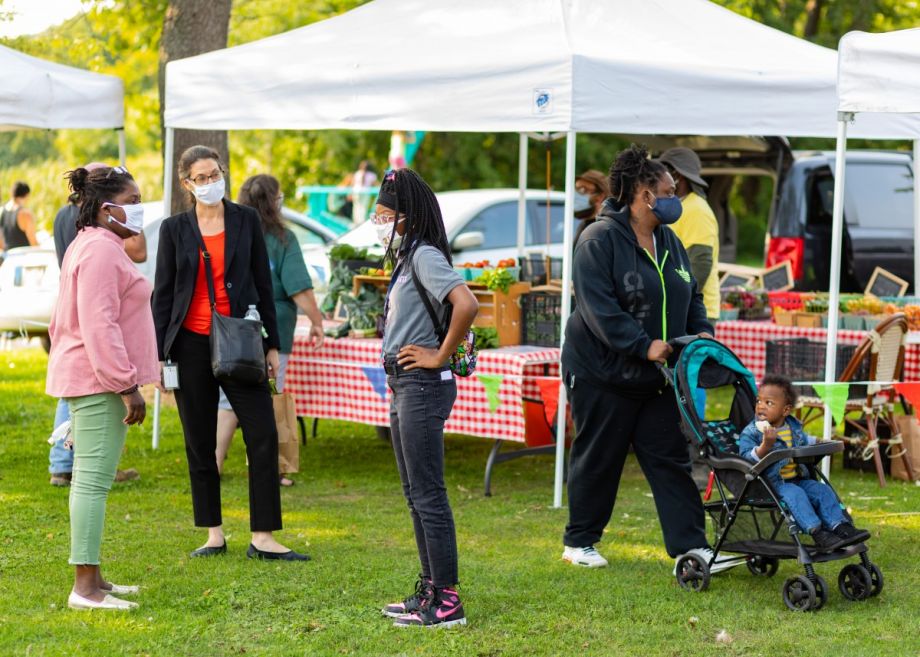EDITOR’S NOTE: RSVP here for Knight’s webinar, “Public Spaces and Technology,” happening Wednesday, April 27, at 3 p.m. Eastern.
The rapid spread of multiple variants is a clear sign that COVID-19 has permanently shaped city life and is here to stay. Many cities across the U.S. are already adapting their urban plans to this new reality of living with the virus. Outdoor public spaces have re-emerged as critical urban amenities in our communities. A rapidly diversifying population is pressing city planners to create more inclusive community spaces. And commercial centers are working to attract remote workers back into urban environments.
Critical COVID-19 relief funds are being activated — stimulus money from the American Rescue Plan and infrastructure dollars that gave cities more resources to attract and retain residents. With additional infrastructure bills stalled in Congress, that might be the only money that city planners eventually see. But many cities waited to spend their funds until the U.S. Treasury offered guidance on how they were legally allowed to use the federally provided funds.
Last month, the Treasury Department officially released guidelines on how to spend the cash, and the uses are broad, freeing cities to choose where to hire personnel and how to bulk up support in different areas of their budget. So how can cities best allocate their stimulus money? An examination of a recent Knight Foundation Community Ties study reveals how residents become — and stay — attached to their cities. Highly attached residents not only stay in a community over time, but they invest time and resources in that community and feel more satisfied with it as a place to live.
Here are the top four lessons from cities that are doing it right. What do these communities have in common? They encourage a thriving city center. They have invested in recreational areas and vibrant public spaces. They boost quality of life through the arts, amenities and digital connectivity. And they take a consciously equitable approach that makes these improvements accessible and available to everyone.
Invest in Quality of Life
The Knight Community Ties study shows that quality of life matters in people’s decisions to move or stay, and it drives how attached they feel to their metro area. People were 54% more likely to stay in their metro area when they chose the community for quality of life reasons.
What exactly does “quality of life” mean? In the study, people pointed to affordable, quality housing, along with the kind of positive neighborhood and city amenities that guided their choice to relocate or remain there. Quality of life can be both emphasized and cultivated with proper investment in key amenities such as recreational areas, arts and cultural activities, and enjoyable places to live, work and play. What pulls people to cities is therefore shapeable; attracting and keeping residents is a result that can come out of conscious planning.
Quality of life factors will only become more important in this post-pandemic era, thanks to a record number of career changes and the widespread embrace of remote and hybrid work.
Additionally, a record number of 18- to-29-year-old adults have chosen to live at home with their parents during the pandemic. As such, cities see enormous potential to engage and attract those younger populations looking for a place to call home.
Former residents who left major metro centers from New York to San Francisco are up for grabs, as are members of the COVID-19 generation who are primed to leave the nest. Given this unprecedented power of choice, it’s up to cities to design an environment that will convince those populations to relocate to an urban center, and stay there.
Cultivate an Active City Center
The death of the city has been greatly exaggerated. New data suggests that, while cities have taken a population hit during the pandemic, the decline is more a matter of temporary moves than permanent shifts. Through early 2021, the largest cities saw small rebounds, with New York City gaining 21,000 residents in the first two months.
That demonstrates a continued desire to live in the city. And, as discussed above, that population shift is set to accelerate. The Knight study makes clear that residents across all cities want to engage meaningfully with urban life. The amount of time people reported spending in the city center had wide-ranging positive effects on both community attachment feelings and behaviors. The more a resident spent time in the center of the city they lived in, the deeper the connection they formed with that city. But the study revealed other key factors at play as well.
“When we looked at data across U.S. cities, big and small, key patterns emerged in what can help boost strong ties between a community and its residents,” said Evette Alexander, Knight’s Director of Learning and Impact. “A thriving city center that residents visit often, vibrant public spaces and recreational areas, easy access to arts and culture, and equitable access to these key amenities foster a deeper sense of community connection.”
Invest in Cultural and Recreational Spaces
To revisit the original question: How should cities spend the funds coming from the American Rescue Plan?
The American Rescue Plan’s impact could re-energize levels of community engagement, but only if the funds are strategically applied. It’s not just a matter of committing the money to amenities, especially if cities want to retain their residents long-term and fend off other competing environments. Particular types of amenities, rooted in arts and culture, can create more engagement and attachment than others.
Arts and culture aren’t always top priorities in city budgets. But as the Knight study makes clear, they should be. Arts and culture ranked head and shoulders above other amenities in terms of their ability to create engagement and attachment. Residents who reported easy access to arts and cultural activities were more satisfied with their communities, felt they were a better lifestyle fit for them and were more likely to be investing in their communities by volunteering and charitable giving. A robustly funded arts scene also creates social bonds that bridge demographics. San Jose and St. Paul, the cities with the highest degree of attachment in the study, also had the highest number of residents who participated in arts-related activities.
“Knight funds artists and cultural organizations because of their inherent ability to connect us to each other and to place, and for their role in making communities vibrant and attractive places to live,” says Victoria Rogers, vice president of the Knight’s Arts program.
In the same study, easy and safe access to recreational areas — parks, beaches and playgrounds — led people to feel as if they fit in better with local culture and lifestyle. They felt more satisfied with their metro area and expressed a desire to stay there long term. If cities want to maximize their post-pandemic recovery and make their COVID-19 relief funding count, they might consider committing resources to build their cultural profile and expand the green spaces of their urban environment.
Guarantee Equitable Access
Each of these initiatives can be prioritized, but without specific attention to equitable access, the results may work against and not for an inclusive community. The Knight study shows that across many communities, residents of color report lower access to key amenities, including recreational and cultural offerings compared to white residents.
“As we strive to build inclusive, equitable and engaged communities, we must put people first in shaping their future city,” says Kelly Jin, vice president for Knight’s Community and National Initiatives program. “Knight’s strategic investments aim to create attachment for residents to their communities by including them in all phases of designing, building and activating public spaces.”
Cities with the highest level of attachment consistently show that, in order for residents to benefit from amenities and recreation areas, equity must be foundational to the approach. Census data shows that the U.S. population is growing more diverse over time. And yet, one-third of Black Americans feel unwelcome in certain parts of their communities, according to recent research by the American Survey Center.
Healthy growth in cities depends on thriving populations across all income brackets. So if cities invest in engagement, but then fail to make that engagement equitable through measures such as consulting with and incorporating affected communities into the planning process, they could severely limit their own futures. The community-engagement approach has seen success across the U.S., in cities ranging from Chicago, whose programming drew 26,000 people to neighborhood spaces across three years, to Detroit, where a community hub led to the growth of new businesses. A recent Knight-Gehl report also found that community participation and responsive engagement are vital for public spaces, and prioritizing inclusive engagement throughout the lifecycle of a space led to greater resident access and use. These strategies are key for cities to pay attention to as they invest in community improvements.
In an era where the shapes of cities are more up for design than ever before, city leaders would do well to invest in advancing a vision that not only reflects the needs and wishes of all residents, but promotes equitable, inclusive and thriving city centers, public spaces, arts and culture programming to attract and retain a diverse population.
James Finley is a writer living in the D.C. area.
















